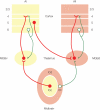Drivers and modulators in the central auditory pathways
- PMID: 20589100
- PMCID: PMC2920527
- DOI: 10.3389/neuro.01.014.2010
Drivers and modulators in the central auditory pathways
Abstract
The classic view of auditory information flow depicts a simple serial route from the periphery through tonotopically-organized nuclei in the brainstem, midbrain and thalamus, ascending eventually to the neocortex. Yet, complicating this picture are numerous parallel ascending and descending pathways, whose roles in auditory processing are poorly defined. To address this ambiguity, we have identified several anatomical and physiological properties that distinguish the auditory glutamatergic pathways into two groups that we have termed "drivers" and "modulators". Driver pathways are associated with information-bearing pathways, while modulator pathways modify these principal information streams. These properties illuminate the potential roles of some previously ill-defined auditory pathways, and may be extended further to categorize either unknown or mischaracterized pathways throughout the auditory system.
Figures


Similar articles
-
Differential innervation patterns of three divisions of frog auditory midbrain (torus semicircularis).J Comp Neurol. 1991 Apr 22;306(4):613-30. doi: 10.1002/cne.903060407. J Comp Neurol. 1991. PMID: 1712796
-
The organization of central auditory pathways in a reptile, Iguana iguana.J Comp Neurol. 1978 Apr 15;178(4):783-831. doi: 10.1002/cne.901780412. J Comp Neurol. 1978. PMID: 632382
-
Diverse functions of the auditory cortico-collicular pathway.Hear Res. 2022 Nov;425:108488. doi: 10.1016/j.heares.2022.108488. Epub 2022 Mar 20. Hear Res. 2022. PMID: 35351323 Free PMC article. Review.
-
Exploring functions for the non-lemniscal auditory thalamus.Front Neural Circuits. 2015 Nov 4;9:69. doi: 10.3389/fncir.2015.00069. eCollection 2015. Front Neural Circuits. 2015. PMID: 26582978 Free PMC article. Review.
-
Chemically defined parallel pathways in the monkey auditory system.Ann N Y Acad Sci. 2003 Nov;999:218-33. doi: 10.1196/annals.1284.033. Ann N Y Acad Sci. 2003. PMID: 14681146 Review.
Cited by
-
The coherent organization of mental life depends on mechanisms for context-sensitive gain-control that are impaired in schizophrenia.Front Psychol. 2013 May 29;4:307. doi: 10.3389/fpsyg.2013.00307. eCollection 2013. Front Psychol. 2013. PMID: 23755035 Free PMC article.
-
Medial geniculate body and primary auditory cortex differentially contribute to striatal sound representations.Nat Commun. 2019 Jan 24;10(1):418. doi: 10.1038/s41467-019-08350-7. Nat Commun. 2019. PMID: 30679433 Free PMC article.
-
A Layer-specific Corticofugal Input to the Mouse Superior Colliculus.Cereb Cortex. 2018 Aug 1;28(8):2817-2833. doi: 10.1093/cercor/bhx161. Cereb Cortex. 2018. PMID: 29077796 Free PMC article.
-
Diversity of Receptive Fields and Sideband Inhibition with Complex Thalamocortical and Intracortical Origin in L2/3 of Mouse Primary Auditory Cortex.J Neurosci. 2021 Apr 7;41(14):3142-3162. doi: 10.1523/JNEUROSCI.1732-20.2021. Epub 2021 Feb 16. J Neurosci. 2021. PMID: 33593857 Free PMC article.
-
Top-Down Inference in the Auditory System: Potential Roles for Corticofugal Projections.Front Neural Circuits. 2021 Jan 22;14:615259. doi: 10.3389/fncir.2020.615259. eCollection 2020. Front Neural Circuits. 2021. PMID: 33551756 Free PMC article. Review.
References
Grants and funding
LinkOut - more resources
Full Text Sources

